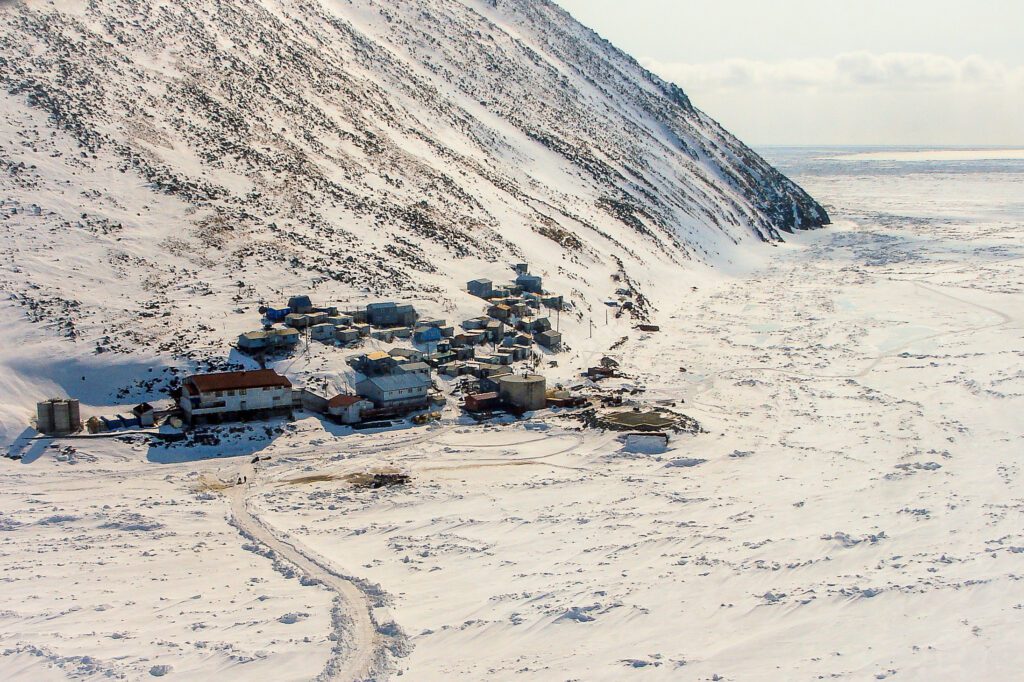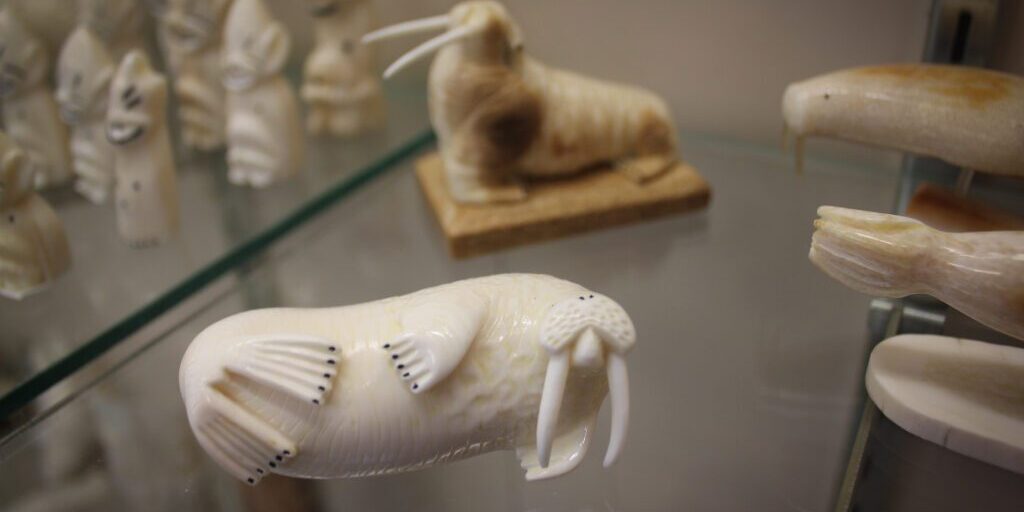Nome, Alaska — The ivory market in America just got a lot smaller, or at least that’s how it seems. A new law that is now effect in California bans the sale of all ivory products, including walrus ivory.
Alaska Natives are protected under a federal law, but confusion and inconsistency between state and federal legislation has many concerned.
John Kokuluk, Sr., is sitting at his carving booth at the King Island Native Community building. He’s an ivory carver and has the hands to prove it.
“I try to make a little bit of everything—masks, polar bears, wolves. I’ve carved quite a few walrus teeth,” Kokuluk explains.
He’s working on one of those teeth today. Dust flies through the air as he drills tiny holes into the two-inch piece of ivory that he’ll later fill in with baleen.

Kokuluk was born and raised in Nome, but his family is from King Island. When members of the Inupiat community were forced to relocate to the mainland in the 1960s, they brought the longstanding tradition of ivory carving with them.
“It’s in our culture. It was passed down long before my time,” Kokuluk explains. “I feel fortunate to have this talent.”
Just like Kokuluk, Susie Silook has been carving for decades. She’s originally from the St. Lawrence Island community of Gambell.
“I love it. I love ivory carving,” Silook says. “We get to say whatever we want with our work.”
It’s that love of carving that led Silook to start an online petition opposing California’s new law that bans the sale of all ivory.
Section 2 of Assembly Bill 96 defines ivory as “a tooth or tusk from a species of elephant, hippopotamus, mammoth, walrus, whale or narwhal.”
“So this is creating this confusion out there that all the materials listed in these laws [are] illegal now,” Silook says.
But they’re not. The Marine Mammal Protection Act of 1972 makes the interstate sale of walrus ivory legal through its definition of authentic native handicrafts.
Gay Sheffield is a biologist with the Alaska Sea Grant Marine Advisory Program in Nome.
“Authentic native handicrafts are defined as items that are produced, decorated, or fashioned in the exercise of traditional Native handicrafts,” Sheffield explains.

Sheffield says the handicraft definition includes, but is not limited to, weaving, carving, stitching, sewing, lacing, beading, drawing, and painting.
Sheffield says she understands the effort to protect elephant and other tusked animals in Africa from poachers, but they’re not one and the same with the marine mammals she studies in the Bering Strait region.
“The general public thinks ivory, elephant, dead elephant rotting in the sun, beautiful elephant with [a] little baby because it’s always on the TV on the documentaries,” Sheffield says. “What they don’t see is walrus ivory, legal harvest, food on the table, economic benefit to rural Alaskans.”
It’s that economic benefit that has many worried.
Carver Susie Silook says ivory brings much-needed cash into rural communities like Gambell. She remembers a buyer from Southeast Alaska traveling to the St. Lawrence Island community in the mid-1990s.
“Within three days, he had purchased $20,000 worth of arts and crafts from the people in just one village, and this is just one buyer,” Silook explains.

But now, buyers are reacting to California’s new legislation. Robert James manages Maruskiya’s, a well-known Native art shop on Nome’s Front Street. He buys from carvers like John Kokuluk, Sr., and sells their crafts in town and on the road.
James had planned to stop at this year’s American Indian Art Show outside of San Francisco.
“Because of the legislation that passed, I don’t think we’ll ever be back there,” James said. “So, we might have to find a different show.”
Back at the King Island carving room, John Kokuluk, Sr., continues to drill tiny holes in the walrus tooth he holds in one hand.
He worries about the confusion the new California law will create for buyers, but Kokuluk says that won’t stop him from carrying on the tradition his ancestors have been practicing for centuries.
“I feel I’ll be doing this, regardless of what happens, probably till the day I’m gone,” Kokuluk says.







